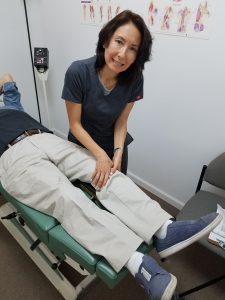
If you have Knee pain from Chondromalacia Patella, Chiropractic can provide relief! This post is about Knee Pain and Chiropractic Treatment: Patellafemoral Arthralgia and Chondromalacia Patella.
You may have anterior (front) knee pain. However, your knee pain may be found behind, in and around your patella (knee cap) as well. It may be vague aching pain that is aggravated by going up and down stairs. Moreover, there may be associated crepitus (cracking or grating) and knee pain going through any squatting maneuver.
Anatomy
The patella (knee cap) is the largest sesamoid bone in the body. Sesamoid bones are a type of bone that develops in some tendons where they cross the ends of long bones. The patella lies within the quadriceps muscle tendon. It functionally extends the lever arm for the quadriceps muscle, making extension (straightening leg) of the knee much more effective.
In addition, stabilization of the patella is provided by the quadriceps muscles, their fascial extensions, and the distal (end) attachment to the tibial tuberosity (boney bump on top of shin bone) via the patellar tendon. The distal (far from the body) end of the femur (thigh bone) and the proximal (nearest from the body) end of the tibia (shin bone) are connected by numerous ligaments and stabilized by strong muscles to form the knee joint. This joint is situated between the body’s two longest “lever arms”. Similarly, it must be able to transmit significant loads as it sustains high forces through upright posture and gait.
Three articulations (joints) are found in conjunction with the knee: the tibiofemoral, patellofemoral, and tibiofibular articulations. However, only the tibiofemoral and patellofemoral articulations participate in knee joint activity. The tibiofibular (fibula is the thin, outer long bone of the leg) articulation/joint does not actually contribute to the actions of the knee. Instead it is part of the ankle joint complex moving the ankle in all the various ranges of motion. However, dysfunctional processes in the proximal tibiofibular articulation/joint can affect other knee functions and can be a source of knee pain.

Difference Between Patellafemoral Arthralgia/arthritis and Chondromalacia Patella
Certainly, biomechanical (study of living body) abnormalities can lead to an erosion and fragmentation of the sub patellar (beneath kneecap) cartilage. This breaking up of the patella articular cartilage due to repetitious stress leads to chondromalacia. It appears that many of the varieties of patellofemoral diagnoses are simply stages of the same overall etiology (cause of disease). However, knee pain from chondromalacia is really a separate diagnosis distinguished from patellofemoral arthralgia.
First, knee pain from chondromalacia is usually due to overuse injury while Patella femoral arthralgia is usually idiopathic (cause unknown).
Second, chondromalacia occurs on the medial facet (middle part) of the patella while patella femoral arthralgia occurs on the lateral facet (toward side) of the patella.
Third, knee pain from chondromalacia occurs in mostly females less than 40 years old. Patella femoral arthralgia occurs in both female and males equally at a greater than 60 years of age.
Lastly, knee alignment in chondromalacia patella can be valgus (knock knee syndrome) or varus (bow leg syndrome). However, the knee alignment is mostly valgus (bow leg syndrome) in patella femoral arthralgia.
Causes of Knee Pain from Chondromalacia Patella
Firstly, patellofemoral syndrome is also called chondromalacia patella. Additionally, it is called “runners knee” since it is common among runners and other athletes. Additionally, it is most frequently seen in teenagers, young adults, women and athletes that engage in sports that put a lot of stress on the knee.
Secondly, knee pain in chondromalacia is often related to maltracking or instability of the patella. So Patella tracking disorder (patella maltracking) describes a condition where movement of your kneecap isn’t aligned. Patella tracking problems can occur primarily from injuries to the knee and quadriceps (group of four muscles that cover the front and sides of your thighs) mechanism. And it can secondarily be in response to problems affecting the ankle or hip.
There are many causes to the maltracking of the patella leading to knee pain in chondromalacia:
- It may be secondary (happens after) to trauma and recurrent subluxation (dislocation).
- Postural problems, “Short leg syndrome”/ leg length inequality
- Underdevelopment of the femoral condyles (rounded protuberance at the end of thigh bone) or the patella
- Patella alta (high riding kneecap)
- Imbalance in musculature for example in your quadriceps (group of muscles in front of thigh). Weak medial (toward middle) knee stabilizing muscles (Vastus Medialis Obliques, one of quadriceps) and tight lateral (toward side) muscles/structures such as the vastus lateralis (side quadriceps) and illio tibial band.
- Excessive femoral torsion (inward twisting of the thigh bone) with resultant irregular “Q angle” (angle formed between the quadriceps muscles and the patella tendon).

Treatment at Meiri Chiropractic of Chondromalacia Patella
Chiropractic manipulative treatment/therapy to the spine and extremities (e.g. limbs) are effective for knee pain in chondromalacia patella. Our other therapies, such as soft tissue techniques, electric muscle stimulation, ice/ heat therapies and homeopathic consultations provide relief. Indeed, postural correction, stretching of tightened muscles, and strengthening of weakened muscles is important for knee pain in chondromalacia patella. Through regular chiropractic visits, you can get pain relief and improve your health without drugs or surgery!
At Meiri Chiropractic we spend the time necessary to examine, diagnose and treat every neuromusculoskeletal condition and various ailments you have. Chiropractic is a holistic and natural way to not only treat existing conditions, but to keep your body in its best working condition. We have been offering effective chiropractic care in Palm Beach county since 2006. Many of our patient reviews note our excellence. Call us today at 561-253-8984 to make an appointment or to find out more about Knee Pain and Chiropractic Treatment: Patellafemoral Arthralgia and Chondromalacia Patella.